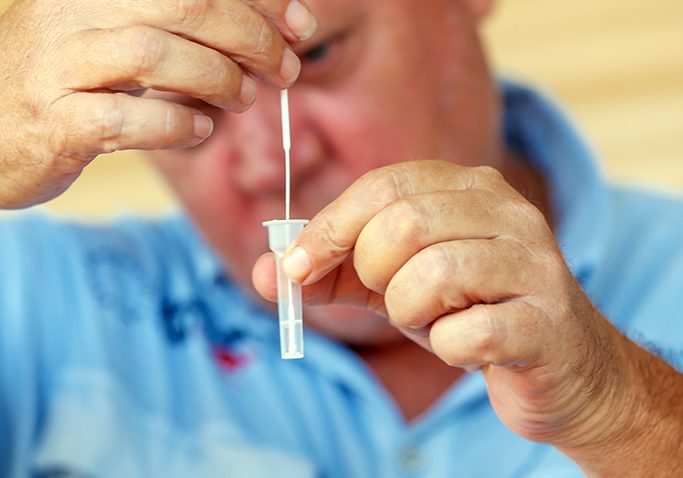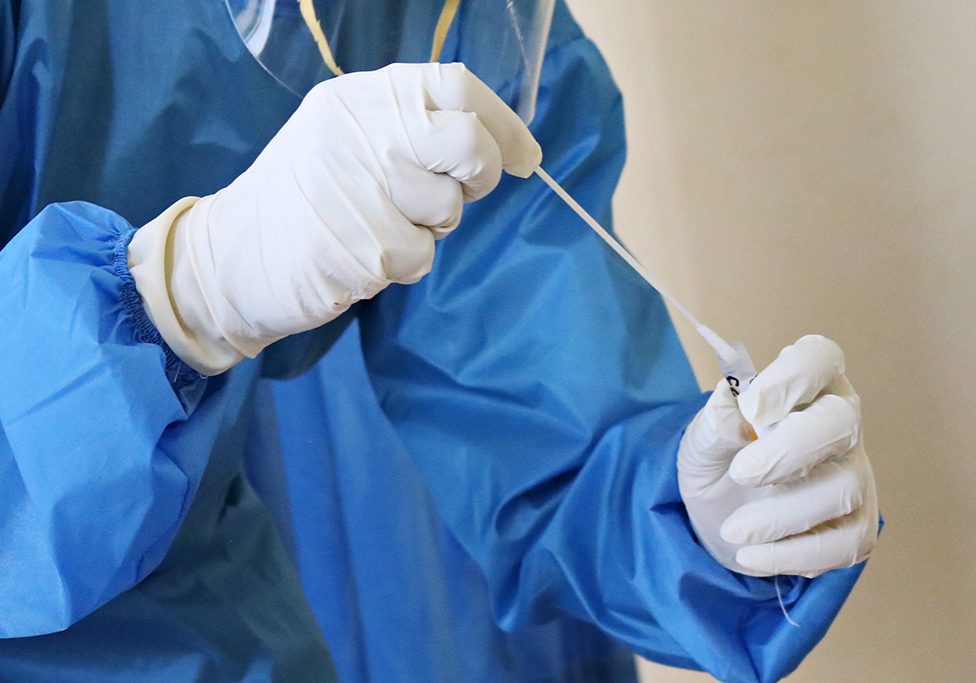By Dr Nick Walsh
As we enter 2022, rapid antigen tests (RATs), have become a core component in our national approach to COVID-19 detection and response. However, this was not always the case.
RATs provide a quick and easy method to detect the presence of the SARS-CoV-2 virus (COVID-19), and can be administered at home, in a workplace, health facility or any site in the community. Results are obtained in 10 to 15 minutes, substantially faster than PCR testing where results take on average between 6 and 36 hours to be reported. This delay in obtaining a PCR test result is not only inconvenient, but can place the community at further risk.
Though RATs have only more recently been embraced by the Australian community, the testing regime has been essential in AUSMAT’s COVID-19 response since the very beginning.
Staff protection was paramount
AUSMAT commenced using RATs on a daily basis for all staff working in high risk COVID-19 environments in November 2020. At that time AUSMAT was running the Howard Springs International Quarantine Facility, that would later be known as The Centre for National Resilience (CNR). While quarantine staff were required to provide nasopharyngeal PCR samples at least twice weekly, local processing capacity meant that there was often a substantial delay in results, up to 24-to-48 hours, compounded by the fact the facility was running on a 24/7 basis.
During December 2020, repatriation flights from the United Kingdom brought an increase in the Alpha variant to Howard Springs International Quarantine Facility. Alpha was more transmissible than the original strain which emerged in late 2019, and an understandable cause for concern for AUSMAT given we were still in the pre-vaccine era.

As an organisation, we introduced daily RATs for staff to provide us with information that could affect operations in the immediacy. If an individual tested positive by RAT, they were to be isolated, and a confirmatory PCR was undertaken. This gave the facility a 24-to-36-hour head start in acting on a positive result.
When the Delta variant emerged in April 2021, we received a high volume of infections on repatriation flights from Chennai and Delhi. This called for continued use of RATs on a daily basis given the greater transmissibility and risk to staff.
2021 also brought further mobilisation of AUSMAT into other jurisdictions here at home and overseas in Timor-Leste, Papua New Guinea, Fiji and India. We adapted our quarantine facility RAT protocol to these other settings.
AUSMATs approach to COVID-19 has been iterative, evidence-based and with a focus on innovation. In our experience, staff feedback emphasised that the ability to test on a daily basis and have an immediate answer was reassuring and reduced anxiety associated with working in a high risk COVID-19 environment.

Frequency key to rapid antigen testing
In Australia there has been substantial debate on the utility and, more specifically, on the sensitivity and risk of false negatives of RATs when compared to PCR tests.
While it is true that the sensitivity of RATs is generally lower than that of SARS-CoV-2 PCR, particularly in the context of asymptomatic infection, the frequency of testing within AUSMAT’s protocols provides compensation for this reduced sensitivity.
Published data suggests that in symptomatic infection, testing on a third daily or more frequent basis results in an effective test sensitivity greater than 95% for RATs, which is equivalent to the sensitivity of PCRs undertaken on a similar frequency.
In addition, not all RATs have similar performance characteristics. The World Health Organization deems acceptable test performance of a RAT needs to be greater than 80%. It is worth noting that the vast majority of RATs have a specificity greater than 99%. This means that while false negatives occur and infections may be missed, the likelihood of a positive being missed is very low.
Now in 2022, AUSMAT continues to use RATs for deployed staff on a daily basis. Tests are self-administered in a group, either in person, or on Zoom every morning prior to work. A positive RAT results in a confirmatory PCR being obtained, isolation and contact tracing.
To date, AUSMAT has only had two confirmed COVID-19 infections during our more than 20 COVID-19 related deployments since the beginning of the pandemic. Both of these infections were detected using RATs.
Australia has now wholeheartedly adopted RATs for use at home, in the workplace, in health facilities as well as in the community for the management of outbreaks. This has resulted in high demand, especially in December 2021 as the Omicron variant arrived on our shores.
There are several caveats that are important to consider in the face of this substantial policy. Firstly, not all RATs have equivalence. Secondly, the collection of the sample is critical - a good sample can make the difference between a positive and negative test, poor sampling may miss infection. Finally, RAT sensitivity is at the most 85% in symptomatic infection and at least 50% in those with no symptoms. So, it is important to remember that if an individual has symptoms but tests negative, the test should be repeated after one or two days as early infection may result in a negative test.
In addition, it has become apparent in the Omicron wave that duration of infection is approximately 10 days, reduced to seven in those vaccinated. In these fully vaccinated individuals, the number of days where the test will be positive is limited because of the shorter infection duration and likelihood of symptoms.
Finally, we always need to consider the epidemiological situation. Where there is a lot of infection in the community, the likelihood of a symptomatic individual who tests negative actually having the disease is of course higher. Whereas if the community test positively rate is falling, there are few infections then the likelihood of an asymptomatic individual testing negative not having the infection, is diminished.
At AUSMAT we continue to follow the international experience and literature in this dynamic and evolving space. RATs have been essential for our ability to continue to operate in high risk environments. They will continue to be a key tool in our ability to mobilise during further waves of this COVID-19 era, and indeed in the post-pandemic phase of endemic COVID-19 infection across the globe.

Dr Nick Walsh
Dr Nick Walsh is the Public Health Specialist in infectious diseases for the National Critical Care and Trauma Response Centre, which includes supporting the prevention and management COVID-19 in international quarantine, domestic and international deployments to disaster and outbreak responses in the region and across Australia. He has attained specialization through the Royal Australasian College of Physicians with a PhD in epidemiology and a clinical background in the emergency and internal medicine in Australia and Asia. He has worked with WHO in public health communicable diseases through both the Asia Pacific and the Americas and continues to support the WHO at the global level in these areas.

